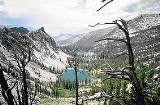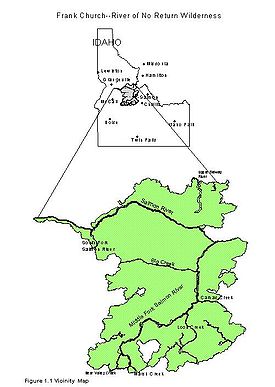
Frank Church-River of No Return Wilderness
Encyclopedia

Idaho
Idaho is a state in the Rocky Mountain area of the United States. The state's largest city and capital is Boise. Residents are called "Idahoans". Idaho was admitted to the Union on July 3, 1890, as the 43rd state....
. It was created in 1980 by the United States Congress
United States Congress
The United States Congress is the bicameral legislature of the federal government of the United States, consisting of the Senate and the House of Representatives. The Congress meets in the United States Capitol in Washington, D.C....
as the River of No Return Wilderness Area, and renamed in 1984 as the Frank Church-River of No Return Wilderness Area in honor of U.S. Senator Frank Church
Frank Church
Frank Forrester Church III was an American lawyer and politician. A member of the Democratic Party, he served as a United States Senator from Idaho from 1957 to 1981....
.
At 2.3 million acres (9,300 km²), it is the second largest contiguous area of protected wilderness in the continental United States, after Death Valley
Death Valley
Death Valley is a desert valley located in Eastern California. Situated within the Mojave Desert, it features the lowest, driest, and hottest locations in North America. Badwater, a basin located in Death Valley, is the specific location of the lowest elevation in North America at 282 feet below...
. Together with the adjacent Gospel Hump Wilderness
Gospel Hump Wilderness
The Gospel Hump Wilderness is a wilderness area located east of Riggins in the state of Idaho. It received wilderness designation in 1978 through the passage of the Endangered American Wilderness Act and is managed by the Nez Perce National Forest....
and surrounding unprotected roadless Forest Service
United States Forest Service
The United States Forest Service is an agency of the United States Department of Agriculture that administers the nation's 155 national forests and 20 national grasslands, which encompass...
land, it is the core of a 3.3 million acre (13,000 km²) roadless area. It is separated from the Selway-Bitterroot Wilderness
Selway-Bitterroot Wilderness
The Selway-Bitterroot Wilderness is a protected wilderness area in the states of Idaho and Montana, in the northwestern United States.At 1.3 million acres , it is one of the largest designated wilderness areas in the United States . It spans the Bitterroot Mountain Range, on the border between...
, to the north, by a single dirt road (the Magruder Corridor). The wilderness contains parts of several mountain ranges, including the Salmon River Mountains
Salmon River Mountains
The Salmon River Mountains are a major mountain range covering most of the central part of the U.S. state of Idaho. The range is over long and its boundaries are usually defined by the Salmon River and its large tributary forks. Part of the central Rocky Mountains, the entire range lies west of...
, the Clearwater Mountains
Clearwater Mountains
The Clearwater Mountains are part of the Rocky Mountains, located in the panhandle of Idaho in the Western United States. The mountains lie between the Salmon River and the Bitterroot Range and encompass an area of .- North Clearwater Mountains :...
, and the Bighorn Crags. The ranges are split by steep canyons of the Middle and Main forks of the Salmon River
Salmon River (Idaho)
The Salmon River is located in Idaho in the northwestern United States. The Salmon is also known as The River of No Return. It flows for through central Idaho, draining and dropping more than between its headwaters, near Galena Summit above the Sawtooth Valley in the Sawtooth National...
. The Salmon River is a popular destination for whitewater rafting
Rafting
Rafting or white water rafting is a challenging recreational outdoor activity using an inflatable raft to navigate a river or other bodies of water. This is usually done on white water or different degrees of rough water, in order to thrill and excite the raft passengers. The development of this...
, and is colloquially known as the "River of No Return" for its swift current which makes upstream travel difficult. Most of the area is covered by coniferous forests, with dry, open land along the rivers at lower elevations.
While designation as a Wilderness Area in the United States generally requires the prohibition of any motorized machinery, the use of jetboat
Jetboat
A jetboat is a boat propelled by a jet of water ejected from the back of the craft. Unlike a powerboat or motorboat that uses a propeller in the water below or behind the boat, a jetboat draws the water from under the boat into a pump inside the boat, then expels it through a nozzle at the...
s (On the Main Fork of the Salmon River) and several airstrips are permitted in this wilderness as grandfathered
Grandfather clause
Grandfather clause is a legal term used to describe a situation in which an old rule continues to apply to some existing situations, while a new rule will apply to all future situations. It is often used as a verb: to grandfather means to grant such an exemption...
existing uses before the wilderness was designated.
History
In 1931, 1,090,000 acres (4,400 km²) in Central IdahoCentral Idaho
Central Idaho is a geographical term located northeast of Boise and southeast of Lewiston in the U.S. state of Idaho . It is dominated by federal lands administered by the United States Forest Service and the Bureau of Land Management. Idaho's tallest mountain, Borah Peak, is located in this region...
were declared by the U.S. Forest Service as The Idaho Primitive Area. In 1963, the Selway-Bitterroot Wilderness was split into three parts: The Selway-Bitterroot Wilderness, the Salmon River Breaks Primitive area, and the Magruder Corridor-the land between the two areas.
Frank Church was the Senate floor sponsor for The Wilderness Act of 1964, which protected 9 million acres (36,000 km²) of United States land as part of the National Wilderness Preservation System
National Wilderness Preservation System
The National Wilderness Preservation System of the United States protects federally managed land areas designated for preservation in their natural condition. It was established by the Wilderness Act upon the signature of President Lyndon B. Johnson on September 3, 1964...
. In 1968, he introduced the Wild and Scenic Rivers Act, which included the Middle Fork of the Salmon River, so that rivers "shall be preserved in free-flowing condition, and that they and their immediate environments shall be protected for the benefit and enjoyment of present and future generations."
Church's environmental legislation culminated in 1980 with the passage of the Central Idaho Wilderness Act. The act created the River of No Return Wilderness by combining the Idaho Primitive Area, the Salmon River Breaks Primitive Area, and a portion of the Magruder Corridor. The Act also added 125 miles (201.2 km) of the Salmon River to the Wild and Scenic Rivers System. In March 1984, weeks before his death, Congress honored Senator Church by renaming the area, The Frank Church—River of No Return Wilderness.
Wildlife
Because of its size the wilderness area provides a secluded habitat for a wide variety of mammal species, including some rare, vulnerable species. The wilderness is inhabited by a large population of mountain lions and grey wolves that visit the area. Populations of black bearsAmerican black bear
The American black bear is a medium-sized bear native to North America. It is the continent's smallest and most common bear species. Black bears are omnivores, with their diets varying greatly depending on season and location. They typically live in largely forested areas, but do leave forests in...
, as well as: lynx
Lynx
A lynx is any of the four Lynx genus species of medium-sized wildcats. The name "lynx" originated in Middle English via Latin from Greek word "λύγξ", derived from the Indo-European root "*leuk-", meaning "light, brightness", in reference to the luminescence of its reflective eyes...
, coyote
Coyote
The coyote , also known as the American jackal or the prairie wolf, is a species of canine found throughout North and Central America, ranging from Panama in the south, north through Mexico, the United States and Canada...
, and red fox
Red Fox
The red fox is the largest of the true foxes, as well as being the most geographically spread member of the Carnivora, being distributed across the entire northern hemisphere from the Arctic Circle to North Africa, Central America, and the steppes of Asia...
are scattered throughout the area. Other observable ruminant
Ruminant
A ruminant is a mammal of the order Artiodactyla that digests plant-based food by initially softening it within the animal's first compartment of the stomach, principally through bacterial actions, then regurgitating the semi-digested mass, now known as cud, and chewing it again...
wildlife within the wilderness include: bighorn sheep
Bighorn Sheep
The bighorn sheep is a species of sheep in North America named for its large horns. These horns can weigh up to , while the sheep themselves weigh up to . Recent genetic testing indicates that there are three distinct subspecies of Ovis canadensis, one of which is endangered: Ovis canadensis sierrae...
, mountain goat
Mountain goat
The Mountain Goat , also known as the Rocky Mountain Goat, is a large-hoofed mammal found only in North America. Despite its vernacular name, it is not a member of Capra, the genus of true goats...
s, elk
Elk
The Elk is the large deer, also called Cervus canadensis or wapiti, of North America and eastern Asia.Elk may also refer to:Other antlered mammals:...
, moose
Moose
The moose or Eurasian elk is the largest extant species in the deer family. Moose are distinguished by the palmate antlers of the males; other members of the family have antlers with a dendritic configuration...
, mule deer
Mule Deer
The mule deer is a deer indigenous to western North America. The Mule Deer gets its name from its large mule-like ears. There are believed to be several subspecies, including the black-tailed deer...
, and white tail deer. While this area has been deemed as one of the few remaining areas in the continental U.S. with suitable habitat for grizzly bears, no established populations are known to exist. The wilderness also offers some of the most critical habitat for wolverine
Wolverine
The wolverine, pronounced , Gulo gulo , also referred to as glutton, carcajou, skunk bear, or quickhatch, is the largest land-dwelling species of the family Mustelidae . It is a stocky and muscular carnivore, more closely resembling a small bear than other mustelids...
s in the lower 48 states.

